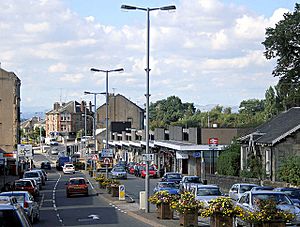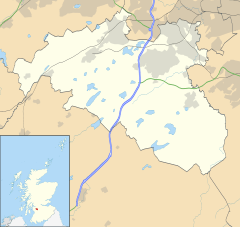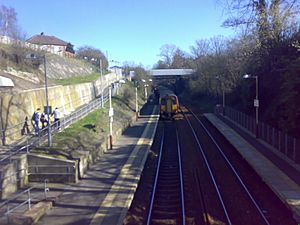Clarkston, East Renfrewshire facts for kids
Quick facts for kids Clarkston
|
|
|---|---|
 Busby Road, Clarkston's main shopping street |
|
| Population | 9,800 (2020) |
| OS grid reference | NS574576 |
| • Edinburgh | 50 mi (80 km) ENE |
| • London | 343 mi (552 km) SSE |
| Council area | |
| Lieutenancy area | |
| Country | Scotland |
| Sovereign state | United Kingdom |
| Post town | GLASGOW |
| Postcode district | G76 |
| Dialling code | 0141 |
| Police | Strathclyde |
| Fire | Strathclyde |
| Ambulance | Scottish |
| EU Parliament | Scotland |
| UK Parliament |
|
| Scottish Parliament |
|
Clarkston (Scots: Clairkstoun, Scottish Gaelic: Baile Chlarc) is a suburban town in East Renfrewshire, in the Central Lowlands of Scotland. A dormitory town with a population of around 10,000, Clarkston is on the southern fringe of the Greater Glasgow conurbation and directly adjoins the neighbouring suburban villages of Busby and Netherlee, as well as the towns of Newton Mearns and Giffnock.
On 21 October 1971, the main shopping building was the scene of the Clarkston explosion, which killed 22 people and injured around 100. A plaque on the site commemorates the event. The building was rebuilt.
Greenbank Garden, a National Trust for Scotland property, is located on Flenders Road, at the outskirts of Clarkston.
History
When a new road from Paisley to East Kilbride was built through the area in the 1790s, a toll point was set up where it crossed what was then the main route from Glasgow to Kilmarnock. A man named John Clark built a house at the toll, and the name 'Clarkston' came to be used for the locality. The Maxwell family (owners of the Williamwood Estate, on which Clarkston was situated) advertised the creation of a new village there in 1801, but initially it grew slowly. Clarkston at this time had no industry of its own, and villagers were mainly employed in the mills at nearby Netherlee.
The area began to expand more rapidly following the opening of Clarkston railway station by Busby Railways in the village in 1866, and later the expansion of the Glasgow tram network to Clarkston in 1921. The 1920s also saw the final breaking up of the Williamwood Estate, encouraging further house building. Clarkston expanded rapidly as new suburban housing developments sprang up such as Williamwood, Carolside and Overlee.
Geography
 |
Giffnock | Stamperland | Castlemilk (Glasgow) |  |
| White Cart Water / Carmunnock (Glasgow) | ||||
| Newton Mearns | Waterfoot | Busby |
| Weather chart for Paisley | |||||||||||||||||||||||||||||||||||||||||||||||
|---|---|---|---|---|---|---|---|---|---|---|---|---|---|---|---|---|---|---|---|---|---|---|---|---|---|---|---|---|---|---|---|---|---|---|---|---|---|---|---|---|---|---|---|---|---|---|---|
| J | F | M | A | M | J | J | A | S | O | N | D | ||||||||||||||||||||||||||||||||||||
|
148
7
2
|
105
7
2
|
112
10
3
|
64
13
5
|
68
16
7
|
66
18
10
|
73
20
12
|
93
19
12
|
113
16
10
|
143
13
7
|
126
9
4
|
135
7
2
|
||||||||||||||||||||||||||||||||||||
| temperatures in °C precipitation totals in mm source: Met Office |
|||||||||||||||||||||||||||||||||||||||||||||||
|
Imperial conversion
|
|||||||||||||||||||||||||||||||||||||||||||||||
At 55°47′9″N 4°16′32″W / 55.78583°N 4.27556°W (55.785°, −4.276°) Clarkston is situated in Scotland's Central Lowlands. The community lies 4.7 miles (7.6 km) east of Barrhead, 3.9 miles (6.3 km) northwest of East Kilbride and 5.57 miles (9.0 km) south of Glasgow. The territory of Clarkston is contiguous with Glasgow and forms part of Greater Glasgow, the United Kingdom's fifth largest conurbation.
Clarkston experiences a temperate maritime climate, like much of the British Isles, with relatively cool summers and mild winters. Regular but generally light precipitation occurs throughout the year.
Clarkston is a postal district within the post town of Glasgow in the G postcode area. Clarkston consists of postcode district G76, which also extends beyond the town boundary to include neighbouring settlements Busby, Carmunnock, Eaglesham and Waterfoot.
Demography
| Clarkston | East Renfrewshire | Scotland | |
|---|---|---|---|
| Total population | 14,944 | 89,311 | 5,062,011 |
| Foreign born | 2.9% | 3.8% | 3.8% |
| Over 75 years old | 7.12% | 6.9% | 7.1% |
| Unemployed | 1.9% | 2.5% | 3.9% |
According to the United Kingdom Census 2001, the census locality (town and sub-area) of Clarkston had a total resident population of 19,944, or 21% of the total of East Renfrewshire. The median age of males and females living in Clarkston was 38 and 41 respectively, compared to 37 and 39 years for those in the whole of Scotland. Fifty-nine percent were married, 3.7% were cohabiting couples, 7.0% were lone-parent families and 23.2% of households were made up of individuals.
The place of birth of the towns residents was 97.1% United Kingdom (including 91.8% from Scotland), 0.5% Republic of Ireland, 0.5% from other European Union countries and 1.9% from elsewhere in the world. Compared with the average demography of Scotland, Clarkston has higher proportions of people born in Scotland and young children (0–15 years old).
Of residents 16–74, 44.0% were in full-time employment, 13.1% in part-time employment, 7.2% self-employed and 1.9% unemployed compared with Scotland as a whole which has 40.3%, 11.1%, 6.6% and 4% respectively. Additionally, in Clarkston 4.5% students have jobs while 4.2% do not, 15.4% are retired, 4.8% look after their home or family, 3.0% are permanently sick or disabled, and 1.9% are economically inactive for other reasons.
Landmarks
Greenbank Garden is a National Trust for Scotland property situated on Flenders Road, consisting of the 18th century Greenbank House and its walled gardens. The house is a Category A listed building.
Transport
The area has a number of road links to neighbouring Glasgow. The A77 main Glasgow to Kilmarnock road passes through Eastwood Toll in the neighbouring town of Giffnock, where it is connected to the A727, which travels from Darnley to East Kilbride, passing through the town centre of Clarkston. This road used to be known as the A726, but was changed to its modern number in the 2000s after a new road was built south of neighbouring Waterfoot and Newton Mearns. This road was built, partly because the A726 was notoriously narrow and busy in this area, and partly to alleviate traffic in nearby Eaglesham. The B767 also travels through Clarkston, from Eaglesham and Waterfoot to Sheddens Roundabout. The road number disappears for a short distance, before reappearing further north, at Clarkston Toll. The road then continues into Netherlee, before ending in Cathcart in the nearby city of Glasgow. The nearest motorway is the M77, of which Junction 3 at Darnley and Junction 4 at Greenlaw, Newton Mearns, which are the main motorway junctions for Clarkston.
Clarkston lies within the Strathclyde Partnership for Transport Passenger transport executive and is served by two railway stations, both of which are managed by ScotRail:
- Clarkston railway station, opened on 1 January 1866 lies on the East Kilbride branch of the Glasgow South Western Line, which runs from Glasgow Central 5 miles (8.0 km) north.
- Williamwood railway station, opened on 9 July 1929, lies on the Neilston branch of the Cathcart Circle 4.7 miles (7.6 km) south-southwest of Glasgow Central.
The closest airport is Glasgow Airport, 8.1 miles (13.0 km) northwest of Clarkston, near Paisley.
Clarkston is serviced by a number of bus routes by various operators. The main bus links are the number 4 and 4A, linking nearby Eaglesham or Newton Mearns with the city centre and Knightswood, and the number 6, which connects East Kilbride with Clydebank. Both services are operated by First Glasgow.
Notable people
Novelist Alistair MacLean lived in the area before moving to Switzerland. Noted residents of the area have included Sir William Kerr Fraser, Principal and Chancellor of Glasgow university; Harry Benson, international photographer, and Judy Murray, tennis educator and promoter.
Pop musicians associated with Clarkston include former Thin Lizzy and Motörhead guitarist Brian "Robbo" Robertson who was born and grew up locally, and Stuart Murdoch of Belle and Sebastian, who also grew up in the area.
See also
 In Spanish: Clarkston (East Renfrewshire) para niños
In Spanish: Clarkston (East Renfrewshire) para niños



